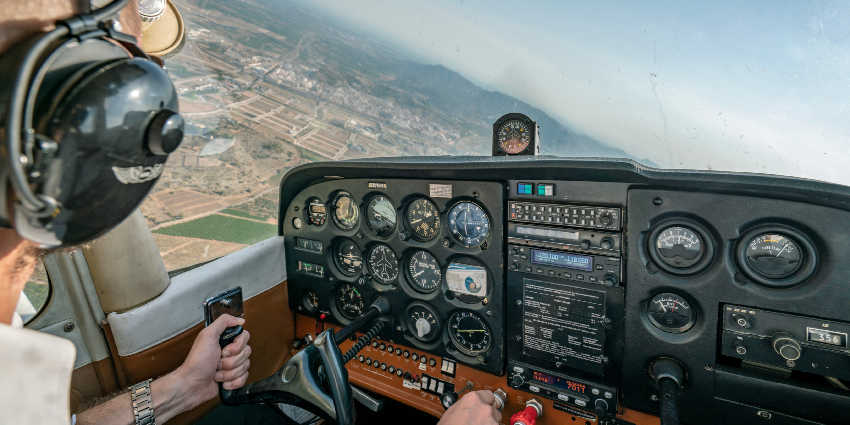Most pilots would tell you that all the money they spend on flying is worth it! With that said, sometimes the amount of money spent can be considerable. However, earning a pilot’s license is within reach of most average people, especially if you apply our five tips for Managing Flight Training Costs.
How To Learn To Fly Without Breaking The Bank
You can't hang around pilots long before someone starts a conversation about how much flying costs. Being brutally honest, flight training isn't like taking a pottery class at the local art center, but it doesn't have to break the bank either. It can be as affordable as you are willing to make it or as expensive as you want it to be. The difference? A few sacrifices on your part.
Learn 5 Ways to Control Flight Training Costs
Don't leave your flight training at the airport. In fact, let it take over a little bit of your life outside the airport. Go to the store or library and study anything you can get your hands on: flying magazines, videos, books, etc. Anything you can bombard your brain with that has to do with flying can help you retain flight training.
Do Your Homework...
Don't go it alone, either. Hang around the airport and talk with other pilots (student, instructor, World War II ace, anybody). Don't get arrested or anything, but surround yourself with good aviation and you will learn and retain before the clock is ticking on your lesson.
Play "Video Games"...
Consider buying a flight simulator "game," like Microsoft Flight Simulator or X-Plane, and a couple of flight control devices, like a stick, throttle, and rudder pedals. You can buy a kit with everything you need for a couple of hundred dollars. You might have to sacrifice a couple of flying hours, but it is usually worth it in the long run.
The more realistic, the better. While this won't be a 100% comparison to flying the real thing, it is still good systems practice. You can spend 200 hours in the simulator flying approaches and playing around for nothing beyond the initial investment that will pay off in the real thing.
Additionally, there are things you can do in the simulator that are impossible in the real world (changing the weather to meet your needs for example).
Take a Ground School Class...
Although it is usually an extra expense if a condensed ground school is offered to take it. It may cost as much as $400 dollars and take a couple of months, but it consolidates a significant aspect of flight training, ground instruction, into one cohesive syllabus.
A condensed ground school isn't required and in fact, you'd cover the same topics with your flight instructor, but having all the fundamentals down makes actual flight training easier. Basically, ground schools are designed to get you ready for the FAA-required knowledge test, while flight training leads to a practical/oral exam.
The knowledge test can be taken irrespective of flight experience and is valid for two years, so you can get it out of the way and focus on completing flight training.
Furthermore, condensed ground schools will offer a gentle introduction to theories put into practice during flight training, which will get you ahead of the curve when you're in the plane.
The alternative, ground instruction during flight training, isn't as effective, because it typically means trying to learn the basics in the aircraft while learning to control it. Honestly, it's a bit like learning to add and subtract during an algebra lesson.
Set a Schedule
Efficient flight training is less-expensive and a quick way to make your training efficient is to set and keep a schedule. Make flight training, or whatever you're learning, a routine and you'll learn more in less time.
If you don't set a schedule, it is easy to let time slip away and then months might pass between lessons. Then rather than moving on to the next thing, you've got to go back and learn everything again.
So, to avoid dragging out your training, set a budget of time and money early in training and stick to it. This will allow you to create a habit of training and keeps you from running out of money right in the middle of your training.
Additionally, if you rent or borrow an airplane, it allows you to schedule lessons well in advance. Just don't take things too far, some flights will be canceled due to weather or other circumstances; make them up if you can, but don't be afraid to go off schedule a little.
Consider a More Economical Airplane
There are some really cool aircraft out there: beautiful old warbirds, high-tech new Cirrus SR-22s, even helicopters. For the most part, you can fly anything you want during your training, but just because you can doesn't mean you should.
Since the aircraft is typically the largest expense in flying, it only makes sense to consider its effect on flight training costs.
Do you really need to rent the brand new $300 an hour Cirrus for your training or could you get by in the $85 an hour Cessna? It may not be as glamorous, but flying the old Cessna can be the difference in spending $4000 for your flight training and $20,000.
Saving money on flight training is a topic that can inspire a library's worth of books, but a few simple changes can really add up. Whether by setting a schedule, playing "games," or simply flying a more economical airplane, little changes and sacrifices can save you thousands of dollars over the course of your training.
